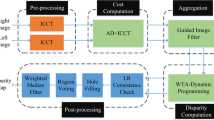Abstract
This article presents an adaptive approach to improving the infection algorithm that we have used to solve the dense stereo matching problem. The algorithm presented here incorporates two different epidemic automata along a single execution of the infection algorithm. The new algorithm attempts to provide a general behavior of guessing the best correspondence between a pair of images. Our aim is to provide a new strategy inspired by evolutionary computation, which combines the behaviors of both automata into a single correspondence problem. The new algorithm will decide which automata will be used based on the transmission of information and mutation, as well as the attributes, texture, and geometry, of the input images. This article gives details about how the rules used in the infection algorithm are coded. Finally, we show experiments with a real stereo pair, as well as with a standard test bed, to show how the infection algorithm works.
Similar content being viewed by others
Explore related subjects
Discover the latest articles and news from researchers in related subjects, suggested using machine learning.References
Adami C (1998) Introduction to artificial life. Springer, TELOS
Scharstein D, Szeliski R (2002) A taxonomy and evaluation of dense two-frame stereo correspondence algorithms. Int J Comput Vision (IJCV) 47(1–3): 7–42
Olague G, Fernández F, Pérez CB, et al (2004) The infection algorithm: an artificial epidemic approach to dense stereo matching. In: Yao X, et al (eds) Parallel problem solving from nature, VIII. Lecture Notes in Computer Science 3242, Birmingham, Springer, pp 622–632
Brown MZ, Burschka D, Hager GD (2003) Advances in computational stereo. IEEE Trans Patt Anal Mach Intell 25:993–1008
Fielding G, Kam M (2000) Weighted matchings for dense stereo correspondence. Patt Recog 33:1511–1524
Luo Q, Zhou J, Yu S, et al (2003) Stereo matching and occlusion detection with integrity and illusion sensitivity. Patt Recog Lett 24:1143–1149
Sun J, Zheng NN, Shum HY (2003) Stereo matching using belief propagation. IEEE Trans Patt Anal Mach Intell 25:787–800
Zitnick CL, Kanade T (2000) A cooperative algorithm for stereo matching and occlusion detection. IEEE Trans Patt Anal Mach Intell 22:675–684
Canny JF (1986) A computational approach to edge detection. IEEE Trans Patt Anal Mach Intell 8:679–698
Olague G, Fernández F, Pérez CB, et al (2006) The infection algorithm: an artificial epidemic approach for dense stereo matching. Artificial Life 12(4):593–615
Pérez CB, Olague G, Fernández F, et al (2005) An evolutionary infection algorithm for dense stereo correspondence. 7th European Workshop on Evolutionary Computation in Image Analysis and Signal Processing, Lecture Notes in Computer Science 3449, Lausanne, Springer, pp 294–303
Sipper M (1997) Evolution of parallel cellular machines. Springer, Heidelberg
Sun C (2001) Fast stereo matching using rectangular subregioning and 3D maximum-surface techniques. IEEE Computer Vision and Pattern Recognition 2001 Stereo Workshop. Int J Comput Vision
Birchfield S, Tomasi C (1998) Depth discontinuities by pixel-topixel stereo. IEEE International Conference on Computer Vision, Mumbai, India, January 1998, pp 1073–1080
Shao J (2001) Combination of stereo, motion and rendering for 3D footage display. IEEE Computer Vision and Pattern Recognition 2001 Stereo Workshop. Int J Comput Vision
Legrand P, Levy-Vehel J (2003) Local regularity-based image denoising. IEEE International Conference on Image Processing, vol. 3, Barcelona, Spain, September 2003, pp 377–380
Author information
Authors and Affiliations
Corresponding author
About this article
Cite this article
Olague, G., Pérez, C.B., Fernández, F. et al. An artificial life approach to dense stereo disparity. Artif Life Robotics 13, 585–596 (2009). https://doi.org/10.1007/s10015-008-0621-6
Received:
Accepted:
Published:
Issue Date:
DOI: https://doi.org/10.1007/s10015-008-0621-6




